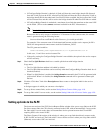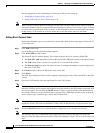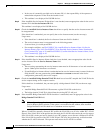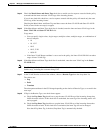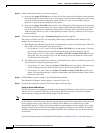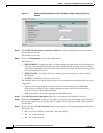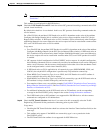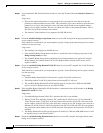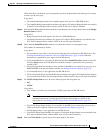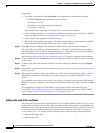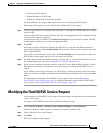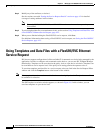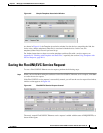
4-17
Cisco IP Solution Center L2VPN and Carrier Ethernet User Guide, 6.0
OL-21636-01
Chapter 4 Managing a FlexUNI/EVC Ethernet Service Request
Setting the Service Request Details
Note For detailed coverage of setting up VLAN translation, see Appendix C, “Setting Up VLAN
Translation.”
This attribute is not displayed for IOS XR devices.
Step 28 Check the N-PE Pseudo-wire on SVI check box to have ISC generate forwarding commands under SVIs
(switch virtual interfaces).
By default, this check box is not checked. In this case, ISC generates forwarding commands under the
service instance.
For a FlexUNI link, the attribute N-PE Pseudo-wire on SVI is dependent on the value of the attribute
Configure with Bridge Domain (this is available in the service request workflow in the EVC Service
Request Editor window). N-PE Pseudo-wire on SVI, if enabled, will be reflected only when Configure
with Bridge Domain is set to true. Otherwise, the service request will not be created with xconnect under
SVI, even if N-PE Pseudo-wire on SVI is enabled.
Usage notes:
• For a FlexUNI link, the attribute N-PE Pseudo-wire on SVI is dependent on the value of the attribute
Configure with Bridge Domain (in the EVC Service Request Editor window). N-PE Pseudo-wire on
SVI, if enabled, will be reflected only when Configure with Bridge Domain is set to true. Otherwise,
the service request will not be created with xconnect under SVI, even if N-PE pseudo-wire on SVI
is enabled.
• ISC supports a hybrid configuration for FlexUNI/EVC service requests. In a hybrid configuration,
the forwarding commands (such as xconnect) for one side of an attachment circuit can be configured
under a service instance, and the xconnect configuration for the other side of the attachment circuit
can be configured under a switch virtual interface (SVI).
• N-PE Pseudo-wire on SVI is applicable for all connectivity types (PSEUDOWIRE, VPLS, and
LOCAL), but a hybrid SVI configuration is possible only for pseudowire connectivity.
• When MPLS Core Connectivity Type is set as VPLS, the N-PE Pseudo-wire on SVI attribute is
always enabled in the policy and service request.
• When MPLS Core Connectivity Type is set as LOCAL connectivity type, the N-PE Pseudo-wire on
SVI attribute is always disabled in the policy and service request.
• For examples of these cases, see configlet examples FlexUNI/EVC (Pseudowire Core Connectivity,
Bridge Domain, Pseudowire on SVI) and FlexUNI/EVC (Pseudowire Core Connectivity, no Bridge
Domain, no Pseudowire on SVI).
• For additional information on the N-PE Pseudo-wire on SVI attribute, see the corresponding
coverage in the FlexUNI/EVC policy chapter in the section
Setting the Interface Attributes.
• The N-PE Pseudo-wire on SVI attribute is not supported for IOS XR devices. All the xconnect
commands are configured on L2 subinterfaces.
Step 29 Check the PW Tunnel Selection check box if you want to be able to manually select the Traffic
Engineering (TE) tunnel for the pseudowire connecting point-to-point N-PEs.
Usage notes:
• Checking the PW Tunnel Selection check box activates the Interface Tunnel attribute field (see the
next step).
• This attribute only appears if the MPLS core connectivity type is set as pseudowire in the
FlexUNI/EVC policy.
• The PW Tunnel Selection attribute is not supported for IOS XR devices.



